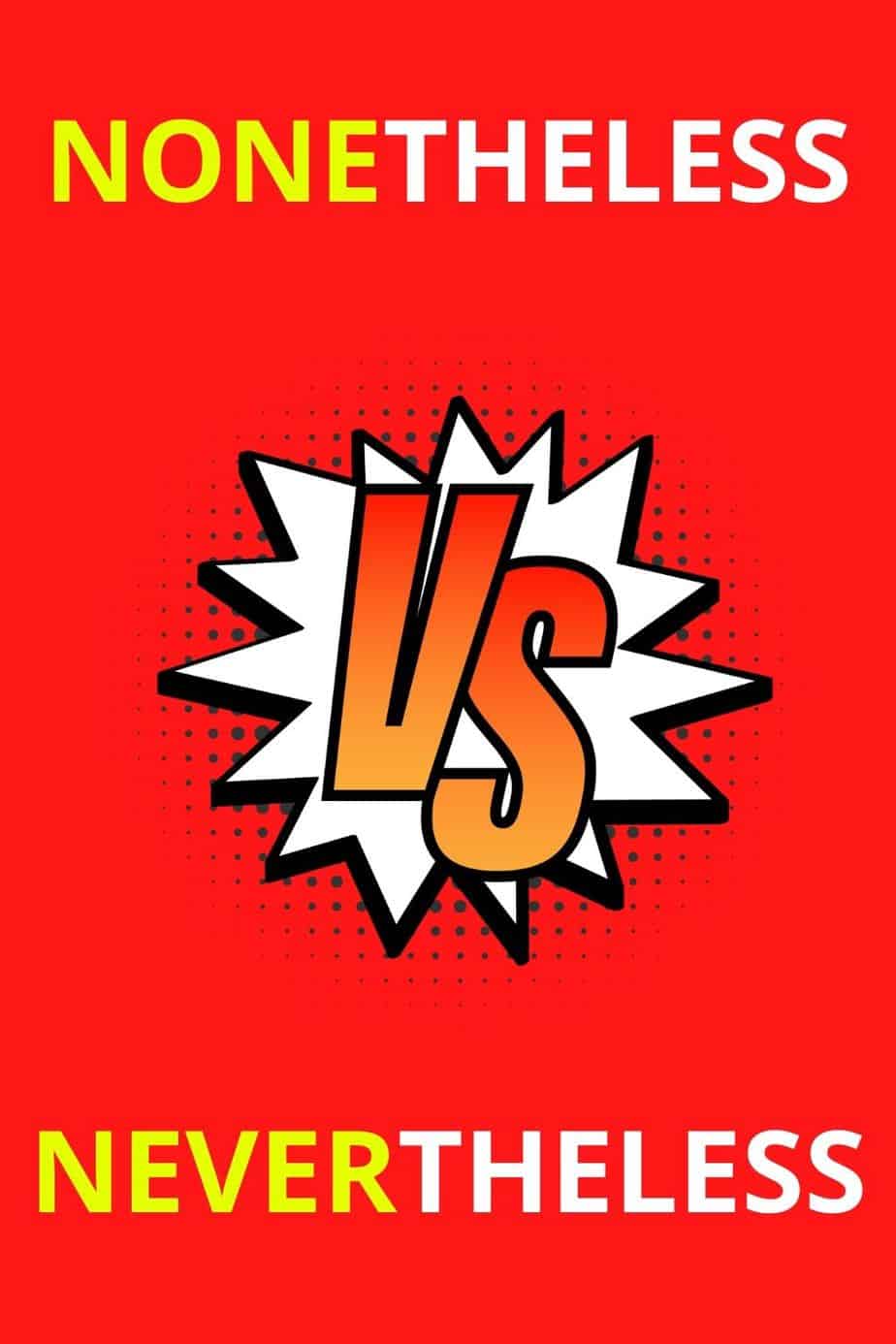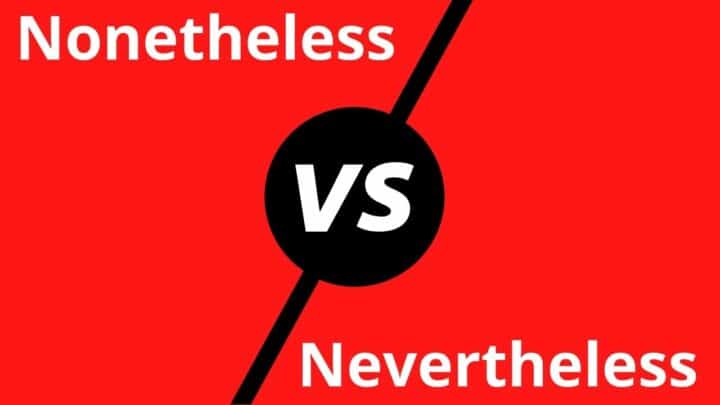Here we go again, asking trivial matters such as the difference between linguistically-luscious words like “nonetheless” and “nevertheless.”
Luckily enough, any concern like this is our daily bread here at Linguaholic because, for us, maybe for you too, language is nourishment.
We kind of breathe language as well, so to speak. So, worry no more because we got your back.
Shall we begin by quickly distinguishing the two?
What is the difference between “nonetheless” and “nevertheless”?
“Nonetheless” and “nevertheless” are largely interchangeable conjunctive adverbs used for talking about contrasting or unexpected outcomes. However, grammar authorities may recommend using “nonetheless” for measurable occurrences of things and “nevertheless” for time-related events.
The confusion between “nonetheless” and “nevertheless” is somewhat like the chicken and egg paradox because of how negligible it should be.
On a more serious note, though, this is comparable to the problem people face between the words “wholistic” and “holistic” in terms of intricacy.
This means that we can only draw the line between these concerns through detailed and comprehensive discussion.
So, I highly recommend that you consider reading until the very end of this post to leave no room for doubt anymore.
Unlike “sale” vs. “sell” whose difference lies in the part of speech, both “nonetheless” and “nevertheless” actually belong under the same part of speech.
“Nonetheless” and “nevertheless” are both adverbs. Although they are adverbs, they actually function like conjunctions or “idea connectors.”
They are more technically known as conjunctive adverbs or adverbial connectors in grammar studies.
Because of this, they obviously work like adverbs and conjunctions at the same time, which is pretty cool.
Both “nonetheless” and “nevertheless” are compound words made up of three words each. Both also suggest the meaning “in contrast to” or “in spite of” what has been said.
Conjunctive adverbs like “nonetheless” and “nevertheless” normally come either at the beginning of the sentence or right after a semicolon.
However, these conjunctive adverbs may also come before verbs, adjectives, and adverbs because they, too, can modify such kinds of words.
By the way, adverbs may come before or after a verb for the most part, although some notable exceptions apply.
“Nevertheless” and “nonetheless” are used in contrasting ideas logically, however mostly written ones, just like their close relatives “notwithstanding” and “albeit.”
Remarkably enough, “nonetheless” is less preferred by most people than “nevertheless” because the latter is reported to “sound better.”

Nonetheless in a nutshell
Suggesting the meaning “in spite of something that has been said or implied,” the adverb “nonetheless” is used less frequently than “nevertheless” in general.
Dictionaries recognize “nonetheless” as a more formal alternative to “nevertheless” despite both words being largely interchangeable.
The meaning of “nonetheless”
The word “nonetheless” may come off as a bit fancy and sometimes intimidating. This is because “nonetheless” is marked as a “somewhat formal” term in wordbooks.
Despite this, “nonetheless” is not really much of a difficult word to use. You can just think of its meaning “in spite of something” if you want to use it.
This “something” usually refers to anything that “has been said or implied” earlier in the text or conversation. The idea introduced by “nonetheless” is something “unexpected.”
Whether we like it or not, “nonetheless” and “nevertheless” are largely interchangeable. This is why this concern is mostly trivial.
However, due to the word “none,” grammar purists may insist that “nonetheless” is best reserved when talking about “measurable” or “quantifiable” ideas and things.
An adverb and a pronoun at the same time, “none” suggests the meaning “not at all” as an adverb and “not one” or “not any” as a pronoun.
Either an adverb or a pronoun, “none” is used to negate the existence or presence of physical and abstract things.
Examples:
The formality level of nonetheless
“Nonetheless” is found mostly in formal discussions. We more likely observe people using easier words like “though,” “but,” or “even so” in casual contexts.
You would likely notice people using “nonetheless” when the conversation or text is related to business, politics, history, and economics – or put simply – the “serious” stuff.
Having that said, using “nonetheless” in extremely casual conversations may invite negative impressions from the listeners. So, avoid it when you can.
The grammar behind “nonetheless”
Made up of three words, none, the, and less, “nonetheless” belongs to the grammatical category called conjunctive adverbs.
When combined, these words make up a connecting device that links one idea to another in a descriptive or explanatory way.
The usage of the phrase “but nonetheless” is also reasonably common among many natives despite its “redundant” meaning.
Grammatically speaking, it is possible to use “but” and “nonetheless” side by side because “but” is a conjunction and “nonetheless” is an adverb.
People do this especially because using either “but” or “nonetheless” alone may not be enough to achieve the target emphasis compared to the two words combined.
In retrospect, that’s just the way it is. That’s simply how the human mind works in terms of making ideas more dramatic.
Albeit stylistically possible, you should meanwhile expect your grammar checker tool to recommend removing either “but” or “nonetheless.”
The usage of “nonetheless” (nonetheless in a sentence)
To date, “nonetheless” has been used less frequently than “nevertheless.” This may still be the case in the near future or so.
Fairly enough, this is understandable because “nonetheless” came into popular usage much later than “nevertheless.”
Only coined in the 1830s and became widely used a century later, “nonetheless” is still a much less preferred word than “nevertheless” in text collections.
Despite this fact, people may still say that “nonetheless” sounds more archaic and stranger than “nevertheless.”
There are several ways on how people make use of the conjunctive adverb “nonetheless,” mostly in writing though.
To see these things more clearly, here are some example sentences using “nonetheless”:
Examples:
In the last example above, you may notice that “nonetheless” is enclosed with two commas. This is because the word is intentionally used to convey some rhetorical effect.
A comma may come before or after “nonetheless” when the writer intends to use it as a parenthetical expression. This may also happen with all almost every other word out there.
Nevertheless in a nutshell
Used to talk about unexpected outcomes as well, “nevertheless” has always been the preferred word among English speakers to date.
Although not necessarily tagged as a formal term, the use of “nevertheless” is also largely limited to written contexts instead of spoken ones.
The meaning of “nevertheless”
“Nevertheless” means “in spite of or in contrast to what has been said.” We could say that it sounds slightly less fancy than “nonetheless,” connotatively speaking.
As “nevertheless” implies the same denotative or dictionary meaning as “nonetheless,” using it in speaking and writing is also not that hard.
What we need to take into account, though, is that a certain idea or situation must be said or implied beforehand if we want to use it effectively.
If you think about it, no one’s really going to criticize your use of “nevertheless” even if you really meant “nonetheless” or vice versa in real-life scenarios.
This is because, again, they are largely interchangeable, suggest the same meaning, and function the same way.
However, grammar authorities may recommend reserving “nevertheless” for time-bound situations, such as things that happened, are happening, or are likely to happen.
The word “never,” an indefinite adverb of time and frequency, suggests either the meaning “at no time” or “not ever.”
Thus, “never” is used to negate or deny the concept of time. When compared to “none,” we can say that “never” suggests a way more powerful, negative meaning.
Examples:
The formality level of nevertheless
In terms of context, “nevertheless” would more likely appear in prose-like texts and more casual discussions when compared to “nonetheless.”
But then again, we should note that both “nevertheless” and “nonetheless” are mostly found in written contexts rather than spoken ones.
Although not limited to, it is easy to find samples of people using “nevertheless” in blogs, online forums, novels, or put simply, in relatively “easygoing” settings.
As more common alternatives to “nevertheless” exist, the usage of this word in extremely casual conversations may still raise listeners’ eyebrows.
So, unless you are trying to impress anyone, it is best to reserve “nevertheless” only when evoking emphasis in argumentative texts and talks.
The grammar behind “nevertheless”
Composed of three words, never, the, and, less, “nevertheless” is also a conjunctive adverb just like “nonetheless.”
In actual language use, “nevertheless” is also commonly paired with “but” because of the more meaningful and more emphatic effect of the two combined.
Like “but nonetheless,” “but nevertheless” is also used a lot by native speakers of English when emphasizing the contrast of ideas.
Technically speaking, “but” and “nevertheless” put side by side, albeit redundant, is grammatically possible.
This is, again, because “but” is a conjunction and “nevertheless” is an adverb. However, if you want to be extra meticulous, try using one or the other only.
The usage of “nevertheless” (nevertheless in a sentence)
Up until now, “nevertheless” is more commonly used when compared to its fraternal twin “nonetheless,” although the latter is getting increasingly more popular, too.
Coined much earlier than “nonetheless” in the fourteenth century, the four-syllable adverb “nevertheless” remains to be the preferred version.
Perhaps, people simply love how the four syllables fit and flow together. Or, maybe, longer words just work better when it comes to conveying contrasts and unexpected outcomes.
Whatever the reason is, most people do prefer using “nevertheless” to “nonetheless.” This makes the English language more unique and interesting to learn.
Here are some ways of how to use “nevertheless” in a sentence to help you decide better:
Examples:
Conclusion
The distinction between “nonetheless” and “nevertheless” is rather elusive to a point of being philosophical, to say the least.
But, as information gets more accessible each day, understanding such subtlety has also become more appealing to many of us.
This is actually great because this simply makes language studies even more daunting than ever.
Frequently Asked Questions on “Nonetheless” vs. “Nevertheless”
Is “nonetheless” more formal than “nevertheless”?
“Nonetheless” is marked somewhat formal in dictionaries, while “nevertheless” isn’t. That said, we could say that “nonetheless” carries a more formal connotation than “nevertheless.”
What’s the difference between “none” and “never”?
“None” can be used either as a pronoun that means “not one” or “not any” or an adverb that means “not at all.” Meanwhile, “never” is only used as an adverb that means “not ever.” While “none” is used for negating existence, “never” is used for negating time and frequency.
Is “none” singular or plural?
“None” can be both singular and plural. In “none of the information here is relevant, “none” is singular because “information” is singular. However, “none” in “none of these movies appeal to me” is plural because “movies” is plural.

Hey fellow Linguaholics! It’s me, Marcel. I am the proud owner of linguaholic.com. Languages have always been my passion and I have studied Linguistics, Computational Linguistics and Sinology at the University of Zurich. It is my utmost pleasure to share with all of you guys what I know about languages and linguistics in general.

